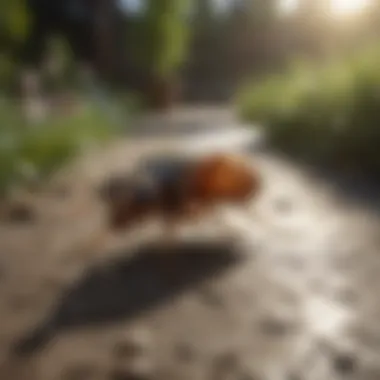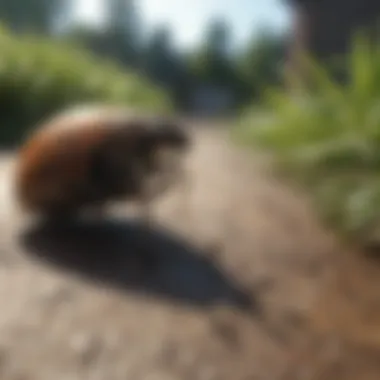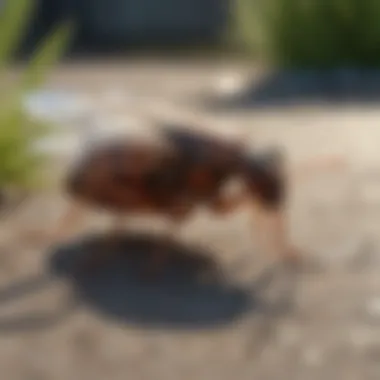Effectively Eliminating Fleas from Your Yard: A Comprehensive Guide


Preventive Pest Control Strategies
When it comes to maintaining a pest-free environment, implementing preventive pest control strategies is crucial. Housewives aiming to safeguard their homes and yards must focus on various measures.
House Exterior Protection
Taking care of the exterior of the house is the first line of defense against pests. Simple tasks like sealing cracks around windows and doors can significantly reduce the entry points for critters. Clearing debris such as fallen leaves and excess vegetation is essential as they provide hiding spots for pests. Additionally, investing in pest-proofing measures like installing door sweeps and screens can help prevent pests from sneaking into the house.
Yard Maintenance
Regular yard maintenance plays a significant role in pest control. Practices like mowing the lawn regularly, trimming overgrown bushes, and removing standing water can deter pests from making themselves at home in the yard. Creating a barrier of gravel or mulch between the house foundation and the yard can also act as a deterrent for pests.
Indoor Cleanliness
Maintaining a clean indoor environment is essential for pest prevention. Implementing expert cleaning tips and techniques can help eliminate food sources and hiding spots for pests. Simple tasks like storing food in airtight containers, wiping countertops regularly, and taking out the trash promptly can go a long way in deterring pests.
Garbage Disposal
Proper garbage disposal is key to preventing pest infestations. Adopting efficient waste disposal methods like using sealed trash bins and composting appropriately can reduce the attraction of pests. Educating household members on the importance of disposing of garbage properly is essential in maintaining a pest-free environment.
Other Pest Prevention Strategies
Aside from the basics, there are innovative ways to safeguard your home against pests. Implementing strategies like setting up ultrasonic pest repellents, using natural deterrents like vinegar or citrus peels, and incorporating plants known for repelling pests can add layers of protection to your pest control efforts.
Understanding Fleas in Yard Environment
Understanding the dynamics of fleas in your yard environment is paramount in maintaining a pest-free outdoor space. By delving into the world of these tiny yet troublesome creatures, you gain valuable insights that can help you tackle infestations effectively. Understanding flea habits, behaviors, and preferences plays a crucial role in developing targeted control strategies. This section serves as the foundation for implementing efficient flea treatment methods, ensuring a healthy and comfortable outdoor environment for you and your family.
Lifecycle of Fleas


The lifecycle of fleas is a fascinating and intricate process that involves four key stages: eggs, larvae, pupae, and adults. Each stage presents unique challenges and opportunities for flea control efforts. Understanding the lifecycle empowers homeowners to disrupt the reproduction cycle of fleas, leading to long-term eradication of these pests. By comprehending how fleas develop from eggs to adults, you can pinpoint vulnerable points in their lifecycle to intervene effectively.
Understanding flea eggs, larvae, pupae, and adult stages
A detailed understanding of flea eggs, larvae, pupae, and adult stages provides crucial information for effective flea control measures. Knowing the characteristics and behavior of each stage enables targeted interventions to halt the lifecycle at vulnerable points. Identifying flea eggs allows for early detection and prevention strategies, while understanding larvae and pupae helps in eliminating hidden infestations. Adult fleas pose direct threats, highlighting the urgency of prompt eradication methods. By grasping the intricacies of each stage, homeowners can tailor their approach to combat fleas efficiently.
Habits of Yard Fleas
Exploring the habits of yard fleas sheds light on their behavior in outdoor environments, enabling a deeper understanding of their survival mechanisms. Fleas exhibit distinct behaviors outdoors, influenced by factors such as weather conditions and landscaping features. By uncovering these habits, homeowners can adopt proactive measures to deter fleas effectively.
Flea behavior in outdoor environments
Understanding how fleas behave in outdoor settings is key to devising targeted control methods. Yard fleas demonstrate specific preferences for breeding and feeding areas, which can guide placement of preventative measures. By studying their behavior patterns, such as jumping abilities and hiding tendencies, homeowners can strategize intervention tactics to disrupt flea activities.
Impact of weather and landscaping on flea population
The impact of weather and landscaping on flea population dynamics underscores the importance of environmental factors in flea infestation. Weather conditions, such as temperature and humidity, directly influence flea activity levels and reproduction rates. Additionally, landscaping elements like dense vegetation provide favorable habitats for fleas. By considering these factors, homeowners can tailor their flea control strategies to tackle infestations effectively. Utilizing weather and landscaping information allows for targeted pest management techniques, creating a hostile environment for fleas and safeguarding your yard against infestations.
Identifying Flea Infestation in Your Yard
Identifying flea infestation in your yard is a crucial aspect of flea control and prevention. By being able to recognize the signs of fleas in your outdoor space, you can take proactive measures to protect your pets and family members from potential harm. This section will delve into the specific elements, benefits, and considerations of identifying flea infestation in your yard within the comprehensive guide on treating fleas.
Signs of Fleas in the Yard
Symptoms in Pets
Understanding the symptoms that manifest in pets due to flea infestation is essential for early detection and effective treatment. These symptoms may include excessive scratching, red and irritated skin, hair loss, and in severe cases, anemia. Highlighting the key characteristic of pets' symptoms helps in connecting the dots between flea presence and their impact. By shedding light on the unique features of symptoms in pets, such as dermatitis or allergic reactions, readers gain insights into why prompt identification is crucial, making it a valuable aspect of this article.
Visual Cues in Yard Vegetation


Visual cues in yard vegetation, such as flea dirt or small, dark specks, provide visible evidence of flea infestation. Specific plants may attract fleas or show signs of damage due to flea activity. Recognizing these visual cues aids in pinpointing areas of infestation within the yard. By describing the uniqueness of how yard vegetation reflects flea presence and the advantages of spotting such cues early, readers grasp the importance of including this aspect in the overall guide. Understanding the interaction between fleas and yard vegetation enhances the reader's ability to combat infestations effectively.
Consequences of Untreated Flea Infestation
Impact on Pets and Family Members
The impact of untreated flea infestation extends beyond mere annoyance, posing risks to both pets and family members. Pets may suffer from skin infections, allergic reactions, and even behavioral changes as a result of prolonged exposure to fleas. Moreover, the discomfort caused by fleas can also affect the well-being of family members sharing the indoor space with infested pets. Emphasizing the key characteristic of this impact sheds light on the interconnectedness between pets and their human counterparts, making it a vital discussion within this article.
Risk of Flea-Borne Diseases
Apart from physical discomfort, untreated flea infestations elevate the risk of transmitting various diseases, including typhus and tapeworm infections. Understanding the potential health hazards associated with flea-borne diseases underscores the urgency of addressing infestations promptly. By portraying the distinct nature of these diseases and their implications, readers can grasp the seriousness of neglecting flea control measures, emphasizing why this discussion is indispensable in the comprehensive guide. Discussing the advantages of mitigating disease risks through flea treatments provides a compelling narrative for readers to prioritize effective yard care.
Effective Flea Treatment Methods for Yards
When it comes to maintaining a pest-free outdoor environment, understanding and implementing effective flea treatment methods for yards is crucial. This section delves into specific elements and considerations that play a vital role in eradicating fleas from your yard, ensuring a healthy and comfortable outdoor space.
Natural Remedies for Flea Control
Essential Oils and Herbal Solutions
Delving into natural remedies for flea control, essential oils and herbal solutions stand out as a promising approach. These options offer a chemical-free alternative with unique characteristics that contribute to the overall goal of flea eradication in yards. The key characteristic of essential oils and herbal solutions lies in their natural properties that repel fleas effectively. This makes them a popular choice for those looking for non-toxic and eco-friendly solutions in combating fleas. However, it's essential to note that while these remedies are beneficial in repelling fleas, they may require more frequent application compared to chemical treatments.
Diatomaceous Earth Applications
Another natural remedy worth considering is diatomaceous earth, known for its effectiveness in flea control. The key characteristic of diatomaceous earth lies in its ability to dehydrate and kill fleas upon contact, making it a popular choice for those seeking non-toxic solutions. Its unique feature as a fine powder that adheres to the fleas' exoskeletons causes dehydration, leading to their demise. While diatomaceous earth is effective, it's essential to apply it strategically in areas with high flea activity to maximize its advantages.
Chemical Treatments and Professional Solutions
Insecticidal Sprays and Granules


Chemical treatments such as insecticidal sprays and granules play a significant role in combating fleas in yards. The key characteristic of these treatments is their fast-acting formula that targets adult fleas, larvae, and eggs, providing quick results. This makes them a popular choice for immediate flea infestations that require swift intervention. However, while these treatments offer effective flea control, they may contain chemicals that could be harmful to pets and humans, necessitating cautious application.
Consulting with Pest Control Experts
For those dealing with severe flea infestations or seeking professional guidance, consulting with pest control experts is a beneficial option. The key characteristic of seeking professional advice is the tailored solutions and expert knowledge they provide, ensuring effective flea eradication. This choice is popular among homeowners who prefer a hands-off approach or face complex flea issues that require specialized treatment. However, it's essential to consider the cost implications and potential chemical exposure when opting for professional solutions.
Maintaining a Flea-Free Yard
Regular Yard Maintenance Practices
In the quest for a flea-free yard, regular maintenance practices play a pivotal role in prevention. The key characteristic of these practices lies in their ability to create an unfavorable environment for fleas to thrive, including mowing the lawn, removing debris, and keeping outdoor areas tidy. This makes them a popular choice for ongoing flea prevention and maintaining a clean outdoor space. While these practices offer effective flea control, consistency and thoroughness are crucial for long-term success.
Preventive Measures to Deter Fleas
Implementing preventive measures to deter fleas is essential in maintaining a pest-free yard. The key characteristic of these measures is their proactive approach in deterring fleas before infestations occur, including using flea-repellent plants, installing barriers, and implementing integrated pest management strategies. This makes them a popular choice for homeowners looking to prevent flea outbreaks and minimize the need for extensive treatment. However, it's crucial to tailor preventive measures to your specific yard environment and stay vigilant in monitoring potential flea activity.
Conclusion
In this comprehensive guide on treating fleas in your yard, the conclusion is a pivotal aspect that ensures the long-term effectiveness of your flea control efforts. By implementing strategic measures to maintain a flea-free outdoor space, you are not only safeguarding your pets and family but also creating a healthy environment for all. Consistent monitoring and intervention strategies play a vital role in this process, allowing you to stay proactive in addressing any potential flea infestations.
Achieving a flea-resistant yard environment is crucial for sustained success in flea control. This section delves deep into cultivating practices and preventive measures that deter fleas from inhabiting your outdoor space. By creating a hostile environment for fleas to thrive, you are significantly reducing the risk of infestation recurrence.
Ensuring Long-Term Flea Control
Consistent monitoring and intervention strategies
Consistent monitoring and intervention strategies involve regular assessments of your yard to detect any early signs of flea activity. By staying vigilant and proactive, you can intervene promptly to address emerging flea issues before they escalate. This approach is all about staying one step ahead of potential infestations, enabling you to maintain a flea-free environment effectively.
One key characteristic of consistent monitoring and intervention strategies is the systematic approach they provide in flea control. By establishing a routine for inspecting your yard, you can identify and address any flea-related concerns promptly. This proactive stance not only prevents infestations but also minimizes the need for extensive treatments in the future. The unique feature of this strategy lies in its preventive nature, which focuses on early detection and prompt action to curtail flea populations efficiently.
Creating a flea-resistant yard environment
Creating a flea-resistant yard environment involves implementing various measures to make your outdoor space inhospitable to fleas. By incorporating landscaping practices and maintenance routines geared towards deterring fleas, you can significantly reduce the likelihood of infestations. This section emphasizes the importance of proactive steps to disrupt the flea life cycle and prevent reinfestation.
One key characteristic of creating a flea-resistant yard environment is its sustainable approach to flea control. By leveraging natural solutions and preventive measures, you are fostering a long-term deterrent against fleas without relying solely on chemical treatments. This eco-friendly and effective method not only safeguards your pets and family but also promotes a harmonious relationship between your yard and its inhabitants. The unique feature of this approach is its focus on holistic flea control, addressing the root causes of infestations while maintaining environmental balance.



